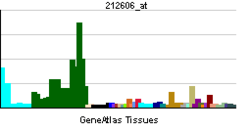WDFY3
| WD repeat and FYVE domain containing 3 | |||||||||||||
|---|---|---|---|---|---|---|---|---|---|---|---|---|---|
| |||||||||||||
| Identifiers | |||||||||||||
| Symbols | WDFY3 ; ALFY; ZFYVE25 | ||||||||||||
| External IDs | MGI: 1096875 HomoloGene: 22855 GeneCards: WDFY3 Gene | ||||||||||||
| |||||||||||||
| RNA expression pattern | |||||||||||||
 | |||||||||||||
 | |||||||||||||
 | |||||||||||||
| More reference expression data | |||||||||||||
| Orthologs | |||||||||||||
| Species | Human | Mouse | |||||||||||
| Entrez | 23001 | 72145 | |||||||||||
| Ensembl | ENSG00000163625 | ENSMUSG00000043940 | |||||||||||
| UniProt | Q8IZQ1 | Q6VNB8 | |||||||||||
| RefSeq (mRNA) | NM_014991 | NM_172882 | |||||||||||
| RefSeq (protein) | NP_055806 | NP_766470 | |||||||||||
| Location (UCSC) | Chr 4: 85.59 – 85.89 Mb | Chr 5: 101.83 – 102.07 Mb | |||||||||||
| PubMed search | |||||||||||||
WD repeat and FYVE domain-containing protein 3 is a protein that in humans is encoded by the WDFY3 gene.[1][2]
This gene encodes a protein which contains WD repeats and an FYVE domain. Multiple alternatively spliced transcript variants have been found for this gene, but the full-length nature of some variants has not been defined.[2]
References
- ↑ Nagase T, Ishikawa K, Suyama M, Kikuno R, Hirosawa M, Miyajima N, Tanaka A, Kotani H, Nomura N, Ohara O (Jul 1999). "Prediction of the coding sequences of unidentified human genes. XIII. The complete sequences of 100 new cDNA clones from brain which code for large proteins in vitro". DNA Res 6 (1): 63–70. doi:10.1093/dnares/6.1.63. PMID 10231032.
- ↑ 2.0 2.1 "Entrez Gene: WDFY3 WD repeat and FYVE domain containing 3".
Further reading
- Nakajima D, Okazaki N, Yamakawa H et al. (2003). "Construction of expression-ready cDNA clones for KIAA genes: manual curation of 330 KIAA cDNA clones.". DNA Res. 9 (3): 99–106. doi:10.1093/dnares/9.3.99. PMID 12168954.
- Andersson B, Wentland MA, Ricafrente JY et al. (1996). "A "double adaptor" method for improved shotgun library construction.". Anal. Biochem. 236 (1): 107–13. doi:10.1006/abio.1996.0138. PMID 8619474.
- Yu W, Andersson B, Worley KC et al. (1997). "Large-scale concatenation cDNA sequencing.". Genome Res. 7 (4): 353–8. doi:10.1101/gr.7.4.353. PMC 139146. PMID 9110174.
- "Toward a complete human genome sequence.". Genome Res. 8 (11): 1097–108. 1999. doi:10.1101/gr.8.11.1097. PMID 9847074.
- Strausberg RL, Feingold EA, Grouse LH et al. (2003). "Generation and initial analysis of more than 15,000 full-length human and mouse cDNA sequences.". Proc. Natl. Acad. Sci. U.S.A. 99 (26): 16899–903. doi:10.1073/pnas.242603899. PMC 139241. PMID 12477932.
- Ota T, Suzuki Y, Nishikawa T et al. (2004). "Complete sequencing and characterization of 21,243 full-length human cDNAs.". Nat. Genet. 36 (1): 40–5. doi:10.1038/ng1285. PMID 14702039.
- Simonsen A, Birkeland HC, Gillooly DJ et al. (2005). "Alfy, a novel FYVE-domain-containing protein associated with protein granules and autophagic membranes.". J. Cell. Sci. 117 (Pt 18): 4239–51. doi:10.1242/jcs.01287. PMID 15292400.
- Gerhard DS, Wagner L, Feingold EA et al. (2004). "The status, quality, and expansion of the NIH full-length cDNA project: the Mammalian Gene Collection (MGC).". Genome Res. 14 (10B): 2121–7. doi:10.1101/gr.2596504. PMC 528928. PMID 15489334.
- Hillier LW, Graves TA, Fulton RS et al. (2005). "Generation and annotation of the DNA sequences of human chromosomes 2 and 4.". Nature 434 (7034): 724–31. doi:10.1038/nature03466. PMID 15815621.